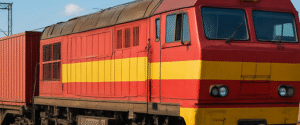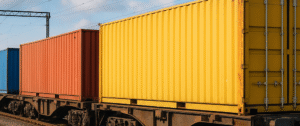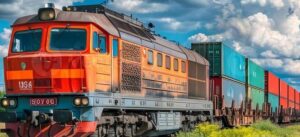What is Rail Freight Transport?
Rail freight transport means moving goods from one location to another by train instead of using trucks, ships, or planes. Unlike passenger trains that carry people, freight trains are built to transport large amounts of raw materials, manufactured items, and other goods. This is known as rail freight.

A Brief History of Rail Freight
Rail freight transport became popular in the early 19th century during the Industrial Revolution.
It started in Germany in the mid-16th century with horse-powered funiculars and wagon ways. Modern rail freight transport began in the early 19th century with British steam locomotives. Great Britain’s railway system is the oldest in the world.
George Stephenson and his son Robert built the first steam engine that carried passengers on a public rail line, the Stockton and Darlington, in 1825. George also created the first public inter-city railway line, the Liverpool and Manchester Railway, which opened in 1830.
Types of goods transported by rail
Trains are versatile they carry:
Raw materials: coal, iron ore, petroleum
Agricultural products: grain, vegetables, fruit
Consumer goods: electronics, furniture, clothing
Containers: mixed goods shipped internationally
How rail freight works: the journey of goods
Think of the train as a moving warehouse. Goods are loaded at one spot, moved to another, travel hundreds of miles, and are then unloaded at their destination. Logistics centers manage scheduling, tracking, and connections with road or ship transport.

Advantages of Rail Freight
Cost-effective: Transporting bulk goods by rail is cheaper than by truck.
Eco-friendly: Trains produce less carbon emissions.
Reliable: Less impacted by traffic jams and weather.
Capacity: Can carry thousands of tons of goods at once.
Challenges Faced by Rail Freight
Although strong, rail freight has its challenges, including:
High infrastructure costs for building and maintaining tracks
Limited door-to-door delivery; trucks are needed for the last mile
Speed limitations compared to air transport
Comparison of rail freight with road and air transport
Road transport is flexible but limited to lighter freight. Air transport is fast but very costly. Rail transport is balanced; it carries heavy freight at a low price, though it is not as flexible as road transport.
The role of rail freight in sustainable development
With increasing climate concerns, rail freight plays an important role. It reduces road congestion, lowers carbon emissions, and supports green logistics by helping businesses transport goods responsibly.
Innovations transforming rail freight
Technology is changing how trains operate:
Digital tracking systems for real-time monitoring
Automated loading and unloading to save time
Electric and hydrogen trains to further cut pollution
Rail freight around the world
In the USA, long freight trains carry coal, oil, and containers. Europe has integrated networks connecting various countries. In China, Belt and Road rail routes link Asia to Europe. India has dedicated freight corridors to minimize delays.
Rail freight in developing countries
Developing nations understand that strong rail freight systems can boost economies. For example, Africa is investing significantly in rail projects to connect ports with inland trade centers.

The future of rail freight
The future looks promising. We can expect faster trains, more eco-friendly systems, and improved networks that connect smoothly with road and sea transport. Rail freight is evolving into a modern logistics hub.
What impact does rail freight have on daily life?
You may not ride a freight train, but your daily life relies on it. The food you eat, the clothes you wear, and even the phone in your hand likely traveled some distance by rail. It is like an invisible bridge connecting factories, farms, and stores to your home.
Conclusion
Rail freight transport may not always be in the spotlight, but it drives economies, links industries, and keeps the world moving. It is reliable, sustainable, and essential to both global trade and our daily lives.
FAQs
What is rail freight transport used for?
It is used to efficiently transport large quantities of commodities such as coal, grain, raw materials and consumer products over long distances.
Why is rail freight transport cheaper than road transport?
Because trains can carry a larger volume of goods at once and thereby have lower fuel and labour costs than trucks.
Is rail freight transport environmentally friendly?
Yes, it emits significantly less carbon emissions than trucks or planes, making it an eco-friendly option.
What are the main disadvantages of rail freight transport?
Higher infrastructure costs, lack of flexibility and slower delivery compared to air transport.
What changes will rail freight transport see in the future?
Expect more automation, eco-friendly engines, digital tracking and faster, more efficient services around the world.

